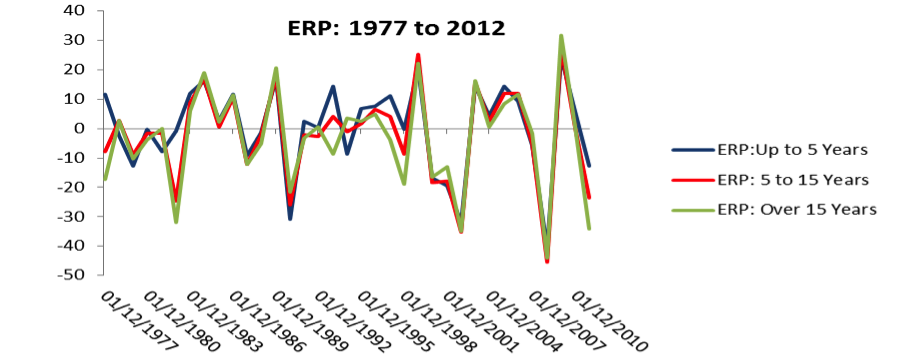How to Calculate Equity Risk Premium
Post on: 20 Апрель, 2015 No Comment

BA Finance
The equity risk premium is an absolutely essential concept in modern-day investing. This is what produces a significant portion of investment profits. The idea behind the equity risk premium is that higher rewards correspond with greater risks.
What Is the Equity Risk Premium?
The equity risk premium is the return an individual stock or the overall market offers over the risk-free rate. Understanding the equity risk premium requires an understanding of the risk-free rate, and understanding the risk-free rate requires an understanding of risk itself.
Risk and the Risk-Free Rate
An equity investment will always bring with it a certain level of risk, which is usually higher than the level of risk associated with debt investment (i.e. bonds). Outside of preferred stocks. there are no guaranteed payments from equity investments. As an investor, you trust that the share of the company you have bought will increase in value as the company grows, increases market share, et cetera. However, the possibility always exists that the company will decrease in value. This is the risk you take, and the more likely it is that a company will fail the more reward you will receive if they succeed. This phenomenon is known as the risk-return tradeoff .
The risk-free rate is a rate of return that does not account for the type of risk described above. It is a rate that simply compensates investors for issues that can arise over a period of time, such as inflation. The risk-free rate is generally derived from the rate of long-term government bonds, since the risk of the government defaulting on these bonds is thought to be almost non-existent.
Calculating the Equity Risk Premium
Investors require higher returns for riskier investments. This requirement is what determines the equity risk premium of a particular stock. The equity risk premium and the risk-free rate comprise the complete return of a stock.
The calculation of the equity risk premium is largely dependent upon the estimates and judgments of investors. It is the price attached to risk, and for this reason it is based on perception. The three steps of the calculation, in their most basic form, are as follows:
- Estimate the expected return on stocks.
- Estimate the risk-free rate.
- Subtract the risk-free rate from the overall expected return to get the equity risk premium.
In equation form: Equity Risk Premium = Expected return on stocks — risk free rate
Estimating the Expected Return
S&P 500 returns
The most feasible road to take to complete this step is to use the expected return on a stock index, such as the S&P 500 or the Dow Jones Industrial Average. as a proxy of the expected return on all stocks. It’s possible to get a decent estimate of this expected return by finding the average of the historical returns the index has experienced.
Estimating the Risk-Free Rate
The government bond that is most appropriate to use as a risk free rate approximater (in the United States, at least) is known as the Treasury Inflation Protected Security — also known as the TIPS. The cost of the TIPS and its periodic payment amounts are adjusted on a semi-annual basis to account for inflation; therefore, its return does not have to be adjusted after the fact.
Finding the Equity Risk Premium
Once the equity risk premium of the overall market is found, we can find the equity risk premium of an individual stock by multiplying the market risk premium by the individual stock’s beta coefficient .
A stock’s beta is calculated by regression analysis and is a measure of its volatility compared to the volatility of the market. It revolves around 1, with lower betas representing less volatility than the market and higher betas representing more volatility than the market.
Interpreting the Equity Risk Premium
Suppose the average historical annual return of the S&P 500 index is 13%. The current rate of return on a 30-year TIPS is 2%. The market’s equity risk premium would be:
Equity Risk Premium = 13% — 2% = 11%
In this case, 11% is the rate of return that investors will require in order to invest in the market rather than risk-free government bonds. Company managers, in addition to investors, will be interested in the equity risk premium, since this will give them a benchmark return to shoot for in order to attract more investors.
Suppose you’re interested in the equity risk premium of Apple. If Apple’s beta coefficient is 1.5, and the market’s equity risk premium is 11%, multiply 11% by 1.5:
Apple’s Equity Risk Premium = 11% x 1.5 = 16.5%
This means that Apple must produce a rate of return of 16.5% in order to attract investors away from risk-free bonds.
Normal Equity Risk Premiums
The equity risk premium calculated above would be a very generous and unrealistic rate of return. Most investors expect an equity risk premium of around 5%. However, academic studies have suggested that even this figure is inaccurate and a much more reasonable risk premium would be around 2.5%.
A Long-Term Prediction
In the end, the equity risk premium is a prediction of how much riskier stocks will outperform less risky bonds over the long-term. The drawbacks of the model include the fact that it assumes the stock market will perform similarly to how it has performed in the past. This can be a dangerous position to take, so a calculated equity risk premium should always be taken with a grain of salt.
There is no guarantee that the prediction will turn into reality, but the equity risk premium is a very good metric to use when choosing which stocks are worthwhile investments.














